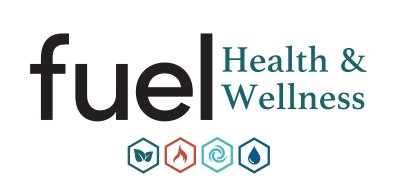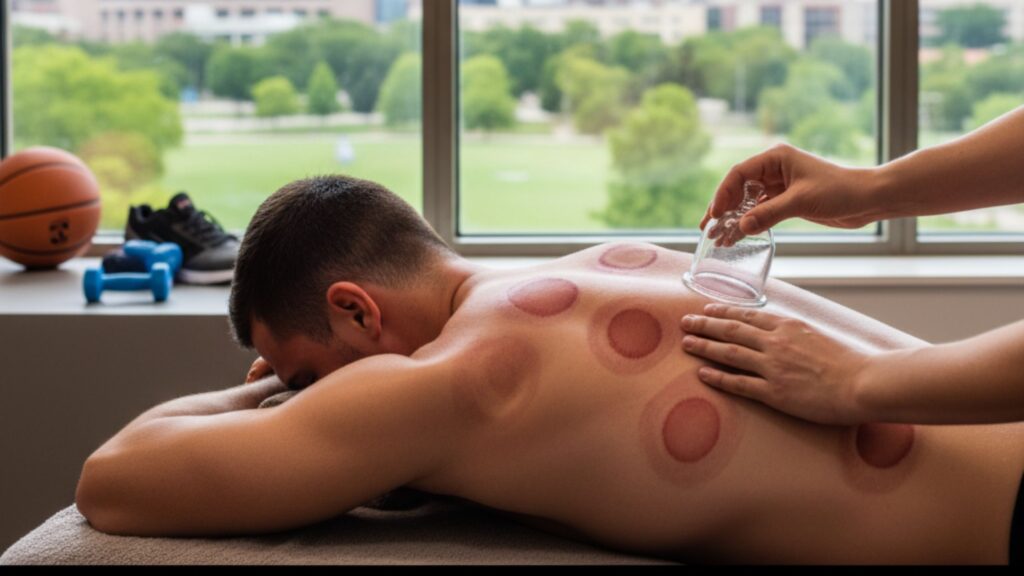For athletes, competitors, and dedicated fitness enthusiasts across West Michigan, the pursuit of peak performance is a constant goal. Every training session, every game, and every road race takes a toll on the body, making recovery just as crucial as the workout itself. You push your muscles to the limit, and you need an effective, proven strategy to restore power, reduce soreness, and prevent future setbacks. This is where a centuries-old practice has found its modern application, becoming the secret weapon for quick recovery: Cupping Therapy Grand Rapids has embraced this technique as an essential part of a comprehensive sports medicine and wellness routine. The visible, circular marks you see on elite competitors like Olympic swimmers and professional basketball players tell a powerful story of deep tissue healing and accelerated recuperation. This detailed guide will explore the profound physiological benefits of cupping and explain why it is the optimal recovery solution for the Grand Rapids athletic community.
The demands of sports, from amateur leagues to high-level college athletics, require a deep understanding of your body’s mechanics. When you experience muscle strains, persistent tightness, or reduced range of motion, traditional rest can sometimes feel too slow. Cupping therapy offers a non-invasive, drug-free method to actively manage post-exertion symptoms, allowing you to return to your routine feeling stronger and more agile. It moves beyond simple massage by utilizing negative pressure to address issues at a deeper, cellular level.
This practice is far more sophisticated than simply placing cups on the skin. It is an intricate therapeutic technique that a trained practitioner executes to target specific muscle groups and fascia layers. By strategically applying suction, the therapist can mechanically lift the skin, muscle, and connective tissue, achieving decompression that manual techniques cannot fully replicate. This decompression is the key to unlocking the body’s natural healing pathways and dramatically accelerating recovery time.
Why is Cupping Therapy a Game-Changer for Local Sports Medicine?
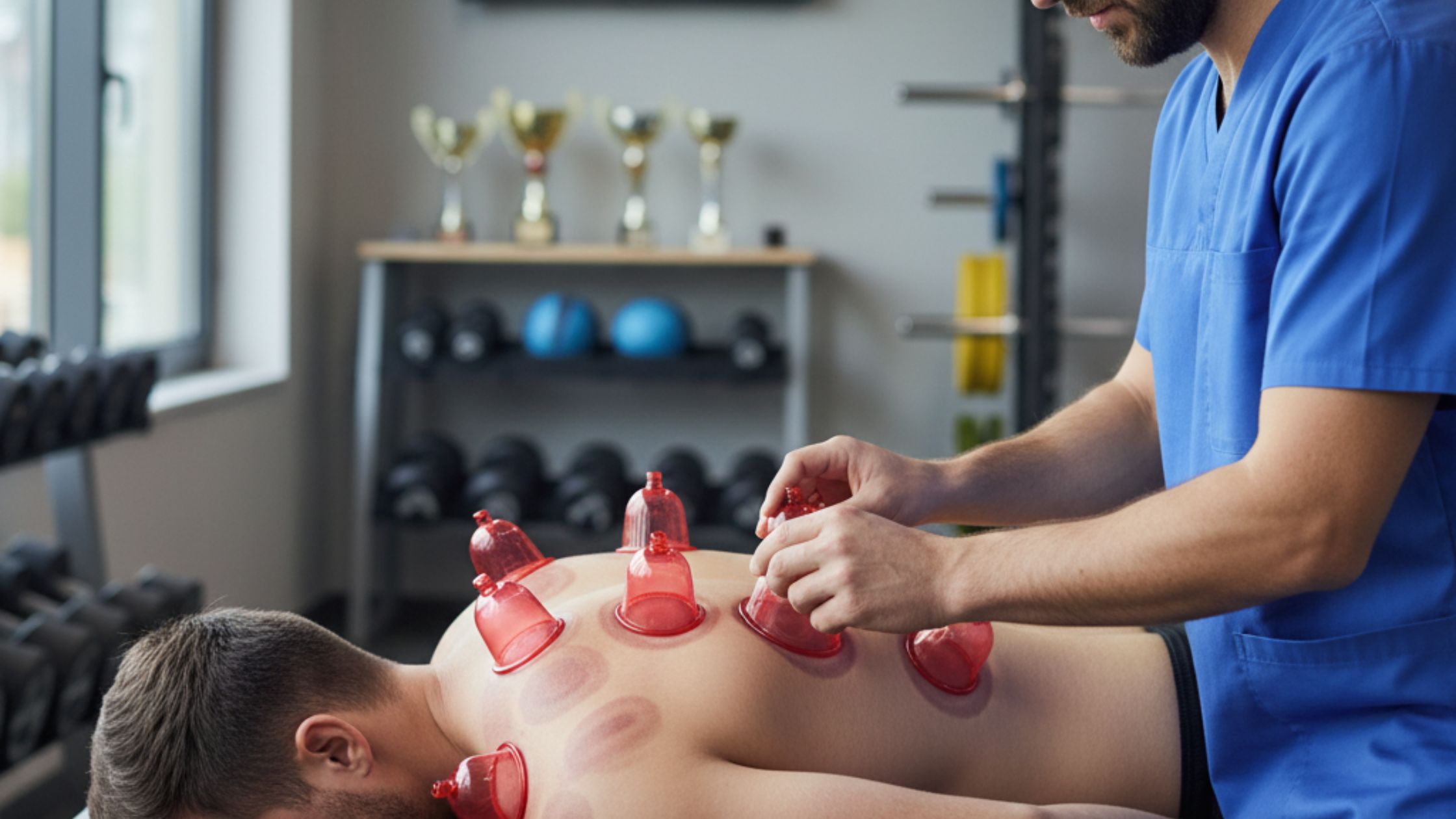
While the ancient origins of cupping lie in Traditional Chinese Medicine (TCM), its modern resurgence is rooted in observable physiological effects relevant to sports medicine. The process begins with the application of specially designed cups—made from glass, plastic, or silicone—to the skin. A vacuum is created either by a mechanical pump, a specialized silicone cup squeeze, or the rapid cooling of heated air, which generates negative pressure on the targeted tissues. This is the foundational principle of all cupping applications.
The suction force gently pulls the skin and superficial muscle layer upwards, achieving two primary goals essential for athletic recovery. Firstly, it encourages a dramatic rush of blood flow and circulation to the specific area, akin to delivering fresh supplies to a muscle site in need of repair. Secondly, this lifting action effectively de-compresses the underlying tissue, separating the layers of myofascial tissue that often become adhered or knotted due during intense or repetitive movement. This dual action is profoundly beneficial for any athlete.
Immediate physiological responses are what make Cupping Therapy Grand Rapids an increasingly popular choice for athletes seeking a rapid bounce-back. Increased local blood flow is critical because it carries essential oxygen and nutrients to damaged cells while simultaneously flushing out metabolic waste products like lactic acid. This waste buildup is the primary cause of post-workout muscle soreness, often referred to as Delayed Onset Muscle Soreness or DOMS.
The Role of Fascial Release in Athletic Cupping Benefits
Understanding the fascia is central to appreciating the athletic cupping benefits. Fascia is a tough, thin casing of connective tissue that surrounds and holds every organ, muscle, blood vessel, and nerve fiber in place. In a healthy state, fascia is smooth and allows muscles to glide easily against each other. However, trauma, repetitive motion, and intense training cause the fascia to tighten, become restricted, and develop adhesions, which limit mobility and contribute to chronic pain.
Cupping is highly effective in promoting fascial release by creating a lift, which is the exact opposite of the compression used in deep tissue massage. This lifting action gently stretches the tight connective tissue layers, effectively breaking up adhesions and allowing the muscle fibers underneath to relax. The relief of this pressure is often immediate, leading to an almost instantaneous improvement in the athlete’s flexibility and range of motion.
- Improved Tissue Glide: By separating the fascial layers, cupping restores the smooth, gliding motion between muscles.
- Reduced Restriction: The lifting action breaks down tissue restrictions that limit movement and cause stiffness.
- Enhanced Hydration: Better circulation helps bring fluid to the fascia, improving its elasticity and overall health.
This targeted release is especially important for athletes in sports requiring extreme flexibility, such as gymnastics, swimming, or golf, but it is equally vital for runners and weightlifters dealing with persistent muscle tension in the hamstrings or shoulders. When fascia is restricted, it pulls on the joints and surrounding tissues, contributing to seemingly unrelated pain points throughout the body.
The Distinct Advantages of Cupping Therapy Over Traditional Massage
While massage therapy is undeniably beneficial for athletic recovery, cupping offers a unique advantage due to its mechanism of negative pressure. Traditional massage applies pressure down onto the muscle, squeezing the tissue. Cupping, conversely, creates a vacuum that pulls the tissue up and away from the body’s deeper structures. This subtle but profound difference is key to the practice’s effectiveness in specific scenarios.
The primary benefit of this “reverse massage” technique is its ability to access and treat deeper, entrenched tissues without causing further strain or discomfort to the surrounding areas. In fact, for athletes with acute muscle strains or highly sensitive areas, gliding cupping (or massage cupping) can provide significant relief where deep manual manipulation might be too painful or even counterproductive to the healing process.
Furthermore, cupping is a potent tool for mobilizing the body’s lymphatic system. The lymphatic system is a network of tissues and organs that help rid the body of toxins, waste, and other unwanted materials. The suction from the cups stimulates lymphatic drainage, helping to quickly clear away inflammation-causing debris and metabolic waste from the area, which is vital for post-workout recovery. This is an essential step in detoxifying overworked muscles and reducing overall systemic inflammation.
Athletes who regularly incorporate cupping into their regimen often report a heightened sense of overall body comfort and relaxation. The non-invasive nature of the treatment, coupled with the profound release of muscle tension, contributes to an overall feeling of decompression. This is partially attributed to the body’s nervous system response; the sensation can trigger the release of natural pain-dampening chemicals, or endorphins, providing natural and immediate pain relief. For athletes facing high-stakes competition or a rigorous training schedule, managing pain and stress is a crucial component of long-term success.
To understand all the nuances of this powerful treatment and how it can be tailored to your specific athletic needs and body, we encourage you to consult with our team of licensed practitioners.
Cupping Techniques: Tailoring Treatment for Grand Rapids Athletes
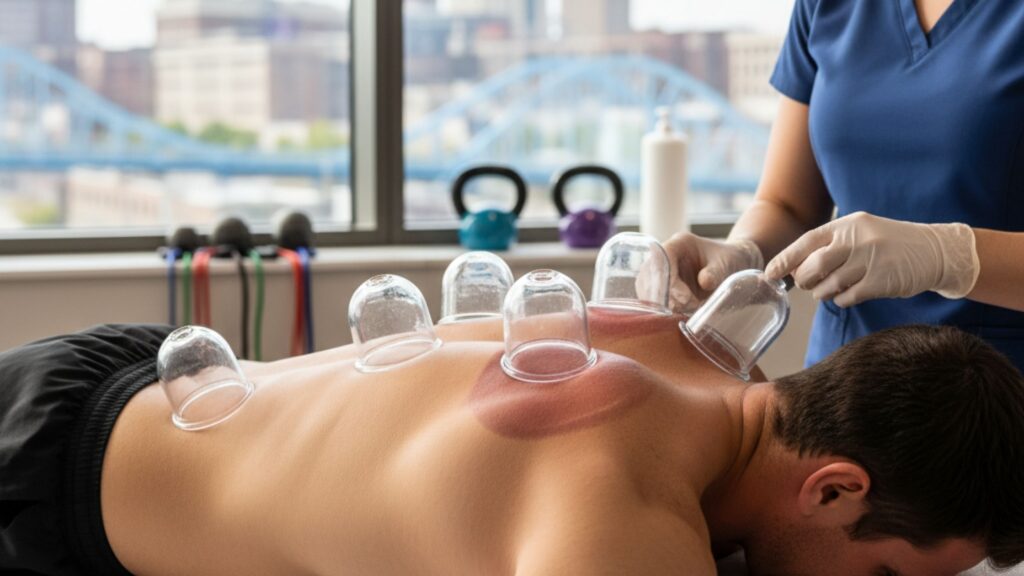
Not all cupping is created equal. A skilled therapist will select from various techniques and cup materials based on the athlete’s sport, the stage of their injury or recovery, and the specific muscle group being treated. This personalized approach is what makes modern cupping therapy a true discipline within local sports medicine.
Dry Cupping (Static Cupping)
Dry cupping is the most common form seen in sports recovery. The cups are placed over a specific trigger point or area of congestion and left in place for a short duration, typically between 5 and 15 minutes. This creates a highly localized suction effect, drawing blood flow and generating the characteristic circular marks. It is ideal for:
- Treating specific, fixed areas of chronic pain.
- Releasing stubborn trigger points and muscle knots.
- Targeting the origin and insertion points of major muscle groups.
The mark left by the cups is a sign that blood has been drawn to the surface, bringing fresh, oxygenated blood to aid the healing process beneath. These marks are not bruises, as they do not involve the crushing of muscle fibers, and they typically fade completely within seven to ten days.
Running or Gliding Cupping
This technique, sometimes called sliding cupping or massage cupping, involves applying a small amount of lotion or oil to the skin before the cups are placed. The therapist maintains the suction and glides the cups across larger muscle groups, such as the back, quadriceps, or hamstrings.
- Myofascial Release: It is exceptionally effective for long-stroke myofascial work, covering significant areas of the connective tissue quickly.
- Warming Up: Often used as part of a pre-event preparation routine to increase circulation and warm up the muscles.
- Detoxification: Excellent for promoting lymphatic drainage and speeding up the removal of lactic acid and other cellular waste products from large muscle bellies.
This moving application provides a deep, pulling sensation that can feel like an intense, therapeutic reverse massage, covering a wider area than static cupping. It is the preferred technique for addressing widespread muscle soreness after a particularly grueling competition.
Wet Cupping (Hijama)
Wet cupping, also known as Hijama, is an ancient method that is distinct from the dry methods used in most athletic recovery centers. This technique involves creating light, controlled superficial skin scratches before the cup is placed. The subsequent suction draws a small amount of interstitial fluid and blood to the surface.
While wet cupping is a common practice in Traditional Chinese Medicine and other cultural healing practices for purported detoxification, modern Western sports medicine often relies predominantly on dry or gliding cupping methods for acute muscle and musculoskeletal issues, focusing on negative pressure for blood flow and fascial release rather than intentional blood-letting.
The key takeaway for any athlete considering Cupping Therapy Grand Rapids is the importance of consulting with an expert to determine the most appropriate technique for their recovery needs. A tailored approach ensures maximum therapeutic effect with the lowest risk of adverse reaction.
How to Integrate Cupping into a Comprehensive Recovery Plan
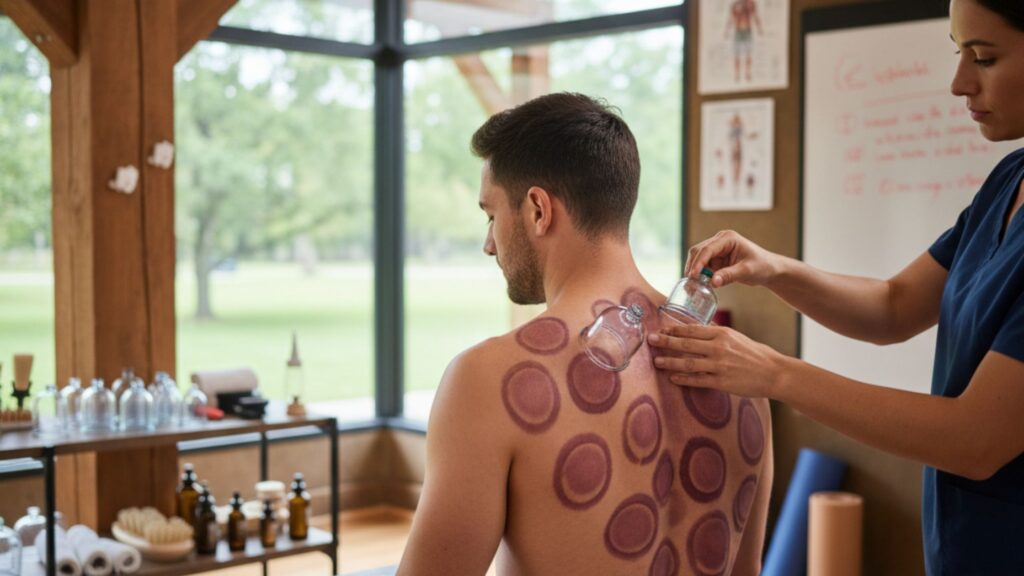
A successful athlete’s regimen is a holistic balance of training, nutrition, and recovery. Cupping therapy should not be viewed as a standalone cure-all but as a powerful, non-invasive modality that works in conjunction with other established treatments. It is most effective when part of a structured program that includes physical therapy, stretching, and proper hydration.
Pre-Event Preparation
Many professional athletes utilize cupping in the days leading up to a major event. A session scheduled 24 to 48 hours before competition can help to:
- Loosen Muscles: Reduce resting muscle tone and tension, ensuring muscles are primed and relaxed.
- Enhance Blood Flow: Increase circulation to the major muscle groups that will be heavily utilized, ensuring optimal oxygen delivery.
- Boost Performance: By improving range of motion and reducing stiffness, cupping can lead to a feeling of lightness and improved athletic ability.
This strategic use for pre-competition preparation is one of the distinct athletic cupping benefits that athletes use to gain a competitive edge. It is a way to ensure the body is in its most mobile and ready state before the starting gun fires.
Post-Competition and Injury Recovery
This is the most common application of cupping in the athletic community. Immediately following intense exercise or competition, muscles are in a state of micro-trauma, inflammation, and stiffness.
- Faster Healing: By reducing inflammation and promoting a massive influx of healthy blood, cupping accelerates the natural healing of muscle strains and other minor injuries.
- Pain Management: The technique directly addresses the source of the pain—muscle tension and fascial restrictions—providing targeted relief that surpasses the temporary effects of many topical creams.
For athletes recovering from a more significant injury, cupping can be integrated into a physical rehabilitation program. It can help loosen scar tissue around an old injury or restore mobility to a stiff joint, often helping patients tolerate other necessary recovery exercises more easily.
If you are an athlete or fitness enthusiast interested in experiencing the healing power of this technique, we recommend scheduling your First Cupping Therapy Session in Grand Rapids to understand its unique sensation and benefit.
Beyond the Musculoskeletal System: Broader Wellness Benefits
While the primary focus of cupping in the athletic world is on muscle recovery and pain management, the therapeutic effects of localized negative pressure extend to the entire body. The suction effect on the skin stimulates the peripheral nervous system, promoting a profound sense of overall calm and relaxation that is invaluable to a high-performing individual.
The modern athlete faces not only physical stress but also the mental strain of demanding training schedules and performance anxiety. The relaxation induced by a cupping session can help to mitigate the effects of this stress, leading to:
- Improved Sleep Quality: Relaxed muscles and a calmed nervous system contribute to deeper, more restorative sleep, which is arguably the single most important factor in athletic recovery.
- Stress Reduction: The release of endorphins and the feeling of having tension physically lifted away from the body can significantly reduce anxiety and improve mental clarity and focus.
- Immune System Support: The overall improvement in circulation and lymphatic drainage is thought to boost the body’s immune function, making the athlete more resilient to common illnesses that can derail training.
This holistic approach to physical and mental well-being is why Cupping Therapy Grand Rapids is not only a physical recovery tool but a cornerstone of comprehensive wellness for individuals who demand peak physical and mental performance from their bodies.
A Deep Dive into Cupping Therapy for Specific Athlete Conditions
The versatile nature of cupping means it can be applied to treat a wide array of specific athletic complaints and regional areas of chronic stress. Understanding its application to these common issues provides a clearer picture of its value in a professional recovery setting.
Back and Shoulder Pain
Athletes involved in overhead sports like baseball, tennis, or volleyball, as well as those who sit for extended periods (cyclists, office workers), often suffer from chronic back pain and shoulder pain. These areas are highly susceptible to fascial restrictions and the build-up of tight, knotted muscle tissue.
Cupping on the trapezius, rhomboids, and erector spinae muscles can effectively decompress the tissues, providing deep relief that lasts far longer than superficial rubbing. The increased blood flow helps loosen the deep muscle fibers and reduce inflammation in the shoulder capsule area, immediately improving rotational movements and reducing the tightness that often leads to injuries like impingement.
Hamstring and Calf Tightness
Runners and sprinters frequently battle persistent tightness in the lower body, leading to a high risk of hamstring or calf strains. Applying Cupping Therapy to these areas, particularly using the gliding or sliding cupping method, can deliver profound myofascial release.
By improving the glide of the fascia over the hamstring muscle belly, cupping directly enhances the extensibility and flexibility of the muscle. This prepares the muscle for increased load and can be a vital preventative measure against pulls and tears, especially during explosive movements.
Post-Surgical and Scar Tissue Management
Following a surgery related to a sports injury, athletes are often left with rigid scar tissue and localized adhesions that restrict movement long after the initial incision has healed.
Cupping can be strategically applied around these areas to gently lift the scar tissue away from the underlying muscle, promoting blood flow and improving the mobility of the scar. This is a crucial, often overlooked step in full recovery, helping to ensure the new tissue is flexible and strong, ultimately enabling a full return to athletic performance. For athletes navigating the complexities of post-op recovery, integrating Cupping Therapy for Athletic Recovery becomes a critical step in their physical therapy protocol.
Understanding the Cupping Marks: What the Marks Indicate
The most recognizable sign of a cupping session is the circular, reddish-purple mark left on the skin. These marks, often mistaken for bruises, are actually an intentional therapeutic result called ecchymosis or petechiae, caused by the localized suction pulling old, stagnant blood from the deeper capillaries to the surface of the skin. This effect is a good indicator of the level of stagnation present in the tissues.
- Dark Purple Marks: Typically indicate an area of significant, long-standing blood stagnation, tightness, and inflammation. This is often where the most dramatic therapeutic effect is needed.
- Light Pink/Red Marks: Suggest a lower degree of stagnation or a more recent, acute issue.
- No Mark: Indicates optimal, healthy blood flow in the area, or that a lighter, gliding technique was used for muscle relaxation rather than deep decompression.
The marks are not painful and fade naturally over a period of 3 to 10 days, depending on the individual’s circulation and the intensity of the treatment. For athletes who regularly use this therapy, the marks often become lighter over time as chronic congestion is cleared from the tissue. This visual feedback can be encouraging, showing a tangible sign that the body’s healing processes have been successfully activated.
Essential Considerations for Your Cupping Therapy Grand Rapids Session
Choosing the right facility and practitioner is paramount for a safe and effective treatment experience. The practitioner should have extensive training in anatomy, sports medicine, and modern cupping techniques, specifically those utilizing the vacuum suction or pump method which allows for precise control over the pressure applied. This level of expertise ensures the therapy is targeted to your precise muscular and myofascial needs.
Safety and Contraindications
While cupping is generally safe, it is not suitable for everyone. A professional consultation is required to screen for any contraindications, which may include:
- Active skin infections, such as eczema or psoriasis, in the treatment area.
- The use of blood-thinning medications.
- Certain blood disorders, such as hemophilia or severe anemia.
- Areas over open wounds or recent trauma.
- Pregnancy, particularly over the abdominal and sacral regions.
A thorough initial evaluation of your health history, current medications, and athletic goals is always the first step. This ensures that the treatment plan is not only effective but also completely safe for your unique physiological profile.
To start your journey toward optimized recovery and learn more about whether this treatment is right for you, we encourage you to contact us to schedule a personalized consultation.
Post-Session Care and Hydration
Maximizing the athletic cupping benefits requires proper post-session care. Since the therapy works to flush out metabolic waste and draw fluids to the treated area, hydration is non-negotiable.
- Hydrate: Drinking plenty of water is essential to help the body flush out the mobilized waste products and support lymphatic system function.
- Rest: Light activity is fine, but strenuous exercise immediately following the session is discouraged. Allow the body a full day of rest or light movement to consolidate the healing benefits.
- Protect the Area: Keep the treated areas warm and protected from extreme cold or direct sunlight.
Adhering to these simple aftercare steps ensures you get the most out of your Cupping Therapy Grand Rapids experience and achieve the maximum acceleration in your recovery timeline. This proactive approach to post-treatment care separates those who get marginal results from those who experience true, transformative pain relief and restored performance. The goal is to facilitate the body’s inherent ability to heal by improving circulation and releasing deep-seated tension.
The Future of Sports Recovery is Here in Grand Rapids
The growing interest in cupping therapy among athletes is not a passing trend; it reflects a shift toward integrating holistic, minimally invasive therapies with conventional sports medicine. Athletes in Grand Rapids are no longer solely relying on rest, ice, and pharmaceuticals. They are seeking out proactive, functional treatments that directly address the mechanical and circulatory factors that impede recovery.
Cupping therapy fits perfectly into this modern recovery philosophy. It offers tangible, visible results by targeting the underlying restrictions in the fascia and boosting the natural process of repair and regeneration. This ancient technique has been validated by its adoption by physical therapists and athletic trainers worldwide, proving its efficacy as a powerful addition to the athletic performance toolkit. When combined with other modalities like corrective exercise and proper nutrition, cupping provides a comprehensive solution for sustaining a high level of performance year-round.
The continued research, even with mixed scientific evidence, consistently points to cupping’s positive effect on improving pain threshold, range of motion, and subjective feelings of recovery. For a dedicated athlete, these experiential benefits translate directly into fewer days off due to soreness and a quicker return to training, providing a critical competitive advantage. Investing in advanced recovery techniques like cupping is investing directly in longevity and sustained excellence in your chosen sport.
The Grand Rapids area has access to some of the finest recovery and wellness specialists who understand how to apply these sophisticated techniques to your unique needs. We are here to guide you through the process, from your first consultation to developing a long-term maintenance plan that keeps you at the top of your game.
Frequently Asked Questions (FAQs) About Cupping Therapy Grand Rapids
How often should an athlete get cupping therapy sessions?
The ideal frequency for an athlete depends on their training cycle and specific recovery needs. During periods of intense training or competition, sessions may be recommended weekly for maintenance and faster recovery. For general wellness or chronic pain, a bi-weekly or monthly session might be sufficient. A qualified therapist will develop a personalized treatment plan based on your sport, intensity level, and body’s response to the therapy.
Does cupping therapy hurt, or is it painful?
Cupping therapy is generally not painful, though you will feel an intense sensation of tightness and pulling, especially when the suction is first applied. Many clients describe it as a deep, warm, and relaxing sensation once the initial pressure subsides. Any slight discomfort that may occur during the session is typically a sign that the practitioner is successfully de-compressing very tight or restricted fascia or muscle tissue.
How long do the circular cupping marks usually last?
The signature circular marks from cupping, which indicate the mobilization of stagnant blood, are not true bruises and should not be painful. The marks can last anywhere from three days to up to ten days. The duration depends on the individual’s circulation, the intensity of the suction, and the degree of underlying congestion in the treated area. The darker the mark, the longer it will typically take to fade completely.
Can I work out immediately after having a cupping session?
It is generally recommended to avoid strenuous, heavy, or high-intensity workouts immediately following a cupping therapy session. The treated area needs time to circulate the new blood flow and consolidate the fascial release. We advise resting for at least 12 to 24 hours post-treatment. Light activities, such as gentle walking or stretching, are usually fine, but avoid anything that will cause further significant muscle tension.
Is cupping therapy scientifically proven or is it just an alternative treatment?
Cupping therapy is considered a form of complementary and alternative medicine (CAM) with ancient roots in Traditional Chinese Medicine (TCM). While anecdotal evidence from athletes is overwhelmingly positive, high-quality, large-scale clinical trials have yielded mixed scientific results. However, many studies show low-to-moderate evidence that cupping can effectively reduce various types of musculoskeletal pain and improve range of motion. It is best viewed as a valuable, low-risk tool to use alongside established physical therapy and local sports medicine practices.
Conclusion
In conclusion, for any dedicated individual looking to maximize their athletic performance and minimize downtime, incorporating Cupping Therapy Grand Rapids into your weekly or monthly routine is a powerful, evidence-informed strategy. The unparalleled ability of the technique to enhance blood flow, promote fascial release, and accelerate the flushing of metabolic waste like lactic acid makes it essential for anyone serious about sustaining peak physical condition. It offers a tangible competitive advantage by addressing muscle soreness and deep tissue restrictions that often linger after intense training. To truly understand the transformative potential of this ancient yet modern therapy, reach out to the specialists at Fuel Health & Wellness.
